Once you learn these basic formations, you will be able to learn guitar chords and play them all over the fretboard. It is an exciting discovery, once you get it and all kinds of new possibilities open up for you.
They are C,A, G, E and D. You might notice that this spells CAGED, which is pretty easy to remember. Every chord you learn after this is based on these 5 chords. Simple, eh?
Exploring The  5 basic Chord Shapes For Guitar
I prefer playing it with my 1st finger, or index finger, on the second fret of the 3rd string, which is the A note. My friends think it’s weird, but think about it: in the key of A you usually play the D and E chords as well. Your 1st finger never leaves the second fret!
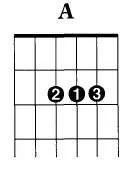 A chord | Guitar Chord Magic – Vol 1: A Guide to Cool Chords & Progressions |
Watch Doc Watson sometime, he keeps his left hand in the basic closed position most of the time. Few people can match him for speed, clarity and precision and this also helps keep the ringing tone in the tune.
 | Pete Huttlinger’s Wonderful World of Chords: A Video Library of Chord Shape |
A lot of Celtic music is in drop D, as is a great deal of finger picking music. With this tuning, it is easy to move up the neck and find all kinds of great spots to play. Drop D is not complicated, only one string changes and it adds a lot of tone to the tune.
Even if you do not drop the bass string, you can just slide the three fingers up and down the neck. This is a very easy way to play other chords up the neck. For example: if you move a D chord up five frets, you get a cool sounding G chord. You just cannot play the bottom two strings, because they are not found in the chord.
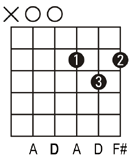 D chord | Easy Guitar Chords and Progressions – An Effortless Way To Make Your Songs Sound Great |
Playing in the key of E with this simple chord opens up all kinds of possibilities for finding good sounding melody notes easily. Just try experimenting with your little finger on any notes you can easily reach and you will see what I mean!
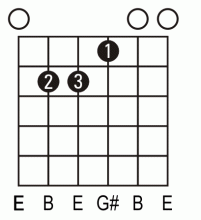 E chord | Easy Guitar Chords and Progressions: Exploring the Key of E | The Guitar Building Blocks Series – Barre Chords and How to Use Them |
It is probably because the little finger is so disobedient and hard to control-at first. With enough persistence, you will soon be using your pinky for all kinds of notes. Learn guitar chords using your little finger and you will be glad you did.
Try this little experiment: move from a G chord to C chord using the two different ways mentioned. You can quickly see that, if your pinky plays the G note on the first string, it is a very simple move to play the C chord. If you play the G note on the first string with your ring finger, a great deal of movement is required to get into a C position.
Not only that, but many songs almost demand the pinky on the first string. Fingerpicking songs are a great example of this. Once you get control of your little finger, you can play all kinds of blues and rock lead runs much easier. Learn guitar chords right the first time around! If you learn guitar chords the right way in the beginning it is much easier.
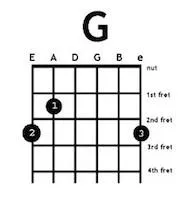 G Chord | 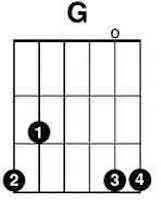 Bluegrass G Chord |
Guitar Chord Magic – Vol 2: Spicing Up Your Fingerstyle Arrangements
Repetition is the key to the highway
All kinds of blues, lead, rock and bluegrass ideas will pop into your head.
The guitar has a unique tuning arrangement and this CAGED system is pretty remarkable, actually totally mathematical. Once you get it, it is easy to learn guitar chords.
I remember sitting on the doorway of my 1965 VW bus when I figured this out on my own. Wow! I knew there was some kind of logic to this thing, but it just hit me and suddenly I had a million ways to play songs. This is the clearest and most sensible way to learn guitar chords, and well worth the effort.
Learn guitar chords by doing it over and over and over
There are many good ways to learn guitar chords using these main chord formations, but the main thing is to play them, over and over and over again. Play them until you can talk and play at the same time; this is a good test to see if you really know how to play.
How to figure out and learn guitar chords
If you know the alphabet from A to G, you can figure out chords. The major chords are always comprised of 3 notes: the 1-3-5 notes of the key. For example: if you want a G chord, you need a G note, a B note and a D note. That’s all. Count on your hand G=1, B=3, D=5
It works like magic for all chords, all the time. You might have to deal with sharps and flats, but that is a different topic.

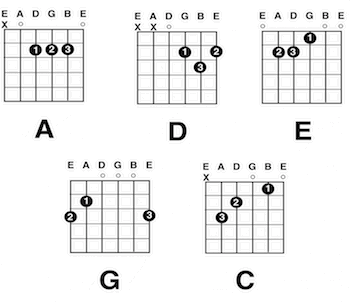
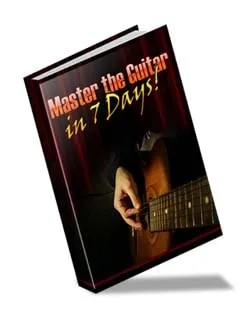 Sign up to receive a free ebook: Master The Guitar in 7 days! (available for a limited period)
Sign up to receive a free ebook: Master The Guitar in 7 days! (available for a limited period)